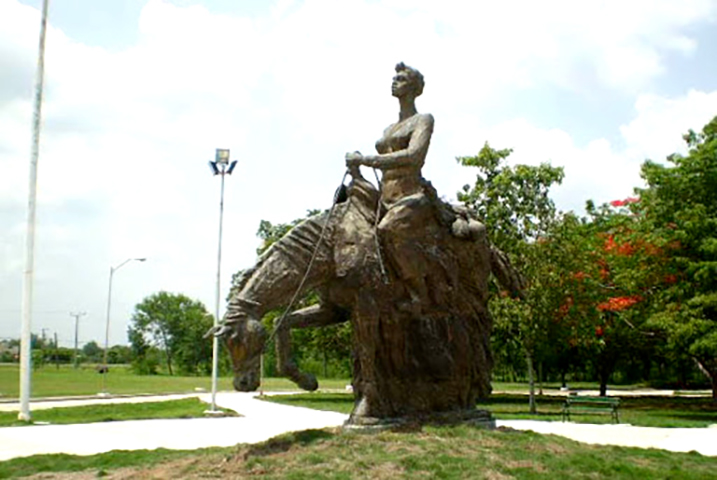Captain Rosa Castellanos, La Bayamesa, saved many lives as a nurse and midwife; she maintained at her expense and under her sole responsibility a blood hospital. Because of her character and her spirit, always independent of her, she went from from being a slave… to being the only Health Captain of the Liberation Army.
Although the references of her in the Cuban History books are not fruitful, it is known that, due to her merits as a mambisa and remarkably humble nurse, Generalissimo Máximo Gómez awarded her the rank of Captain of Health. Although she was born in Bayamo in 1830, and she joined the independence struggle that broke out in 1868, Camagüey welcomed her both in the war and in the days of peace.
September 25th, 1907
In San Isidro Street (which today bears her name) number 22, early in the morning, at approximately 8 o’clock, surrounded by those closest to her, she passed away;. At 12 noon, her remains were transferred to the City Hall and for 30 hours the people of Camagüey passed by in front of her coffin, as a sign of love and respect for those who knew how to win it.
At 7:00 p.m. that same day and year, the councilors Messrs. Pedro Guzmán, Oscar Ávila, Esteban Castellanos, José Reyes, Carlos Guerra, Filiberto Pichardo, Fernando Mendoza and Emilio Arteaga met in Camagüey city; and before starting the agenda, it was agreed, at the request of Mr. Arteaga, to record in the minutes the deep feeling of the corporation for the death of the well-named Sister of Charity of the fields of the Revolution, Mrs. Rosa Castellanos and Castellanos (La Bayamesa).
The shoulders of the children of this land disputed the honor of moving her in her last moments to the General Cemetery. There, among flowers, tears, solemn music; her body was placed in the second niche of vault 71 of the first section.
Heaven also wept at her departure
Heavy rain accompanied the funeral. The crowd continued its march, nothing stopped it, nor did it diminish the singular act. As time passed, her remains were going to be thrown into a mass grave, but humble cemetery workers, moved by the force of this woman’s personality, safeguarded them with all solemnity. Twenty years after her physical disappearance, the Territorial Council of Veterans transferred her relics to the Veterans Pantheon.
The Victoria Association and Nicolás Guillén always remembered her
The closeness of the poet with Rosa, beyond the principles, was practically familiar; because her father, Nicolás Guillén Urra, was the executor of the distinguished patriot. On May 14th of the same year of her death, the Open Will was made. The notary José Agustín de Socarrás y Recio, in the testator’s own house and before the required witnesses, performed the service:
He testified: that she is single and has not left an estate; she left Mr. Nicolás Guillén Urra as guarantor of everything related to her funeral and burial, as well as sole and universal heir of all assets, rights, actions and future successions. To whom she cared for her last moments, Fecunda Camacho González, she bequeathed the amount of 200 pesos in attention to the good services and assistance that she has been providing during her illness. The witnesses Celestino Betancourt Chávez, Ramón Socarrás Yzquierdo and José Bello Sánchez signed, but not the testator for stating that she did not know and the witness Celestino Betancourt does so at her request.
In 1943, at the Victoria Society led by the ’68 Club, a tribute was made to the Homeland on the anniversary of her death. After the pilgrimage to the Veterans Pantheon, Dr. Roberto León Expósito spoke. During the night, in the halls of the Victoria Society, a patriotic act was carried out, where the poet Nicolás Guillén gave a eulogy.
Immortalized in an equestrian sculpture
The Cuban plastic artist, Alberto Lescay Terencio, placed a bronze equestrian sculpture, located on a hill, in the park-monument dedicated in Bayamo to Rosa Castellanos, La Bayamesa. It reaches six meters high and presents the mambisa accompanied by a machete, a yarey hat, a turban and allegorical elements related to her work as a nurse.
Bibliography
AHPC: Fondo Ayuntamiento: Segundo tomo del Protocolo de instrumentos públicos del año mil novecientos siete.
Translated by: Aileen Álvarez García







